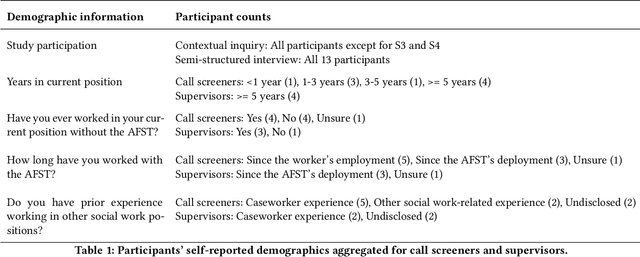Diana Qing
Imagining new futures beyond predictive systems in child welfare: A qualitative study with impacted stakeholders
May 18, 2022



Abstract:Child welfare agencies across the United States are turning to data-driven predictive technologies (commonly called predictive analytics) which use government administrative data to assist workers' decision-making. While some prior work has explored impacted stakeholders' concerns with current uses of data-driven predictive risk models (PRMs), less work has asked stakeholders whether such tools ought to be used in the first place. In this work, we conducted a set of seven design workshops with 35 stakeholders who have been impacted by the child welfare system or who work in it to understand their beliefs and concerns around PRMs, and to engage them in imagining new uses of data and technologies in the child welfare system. We found that participants worried current PRMs perpetuate or exacerbate existing problems in child welfare. Participants suggested new ways to use data and data-driven tools to better support impacted communities and suggested paths to mitigate possible harms of these tools. Participants also suggested low-tech or no-tech alternatives to PRMs to address problems in child welfare. Our study sheds light on how researchers and designers can work in solidarity with impacted communities, possibly to circumvent or oppose child welfare agencies.
Improving Human-AI Partnerships in Child Welfare: Understanding Worker Practices, Challenges, and Desires for Algorithmic Decision Support
Apr 05, 2022

Abstract:AI-based decision support tools (ADS) are increasingly used to augment human decision-making in high-stakes, social contexts. As public sector agencies begin to adopt ADS, it is critical that we understand workers' experiences with these systems in practice. In this paper, we present findings from a series of interviews and contextual inquiries at a child welfare agency, to understand how they currently make AI-assisted child maltreatment screening decisions. Overall, we observe how workers' reliance upon the ADS is guided by (1) their knowledge of rich, contextual information beyond what the AI model captures, (2) their beliefs about the ADS's capabilities and limitations relative to their own, (3) organizational pressures and incentives around the use of the ADS, and (4) awareness of misalignments between algorithmic predictions and their own decision-making objectives. Drawing upon these findings, we discuss design implications towards supporting more effective human-AI decision-making.
 Add to Chrome
Add to Chrome Add to Firefox
Add to Firefox Add to Edge
Add to Edge